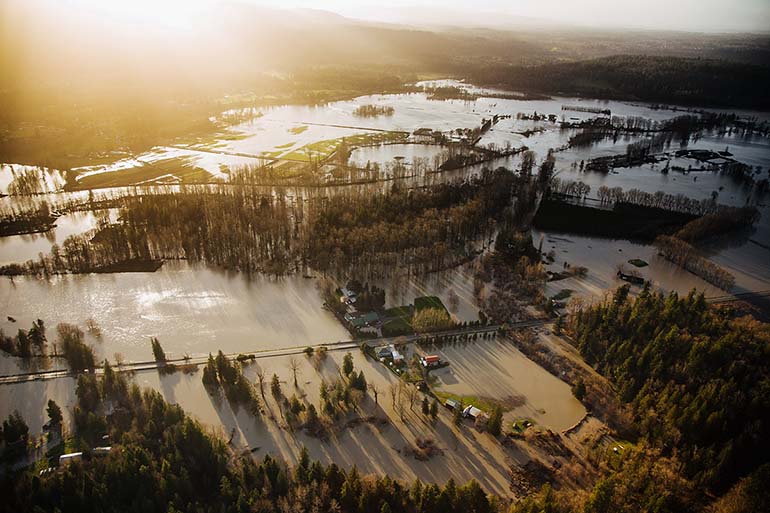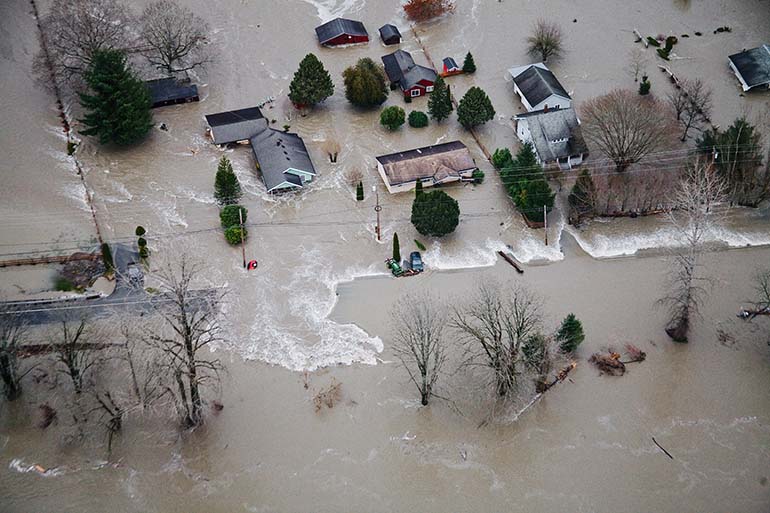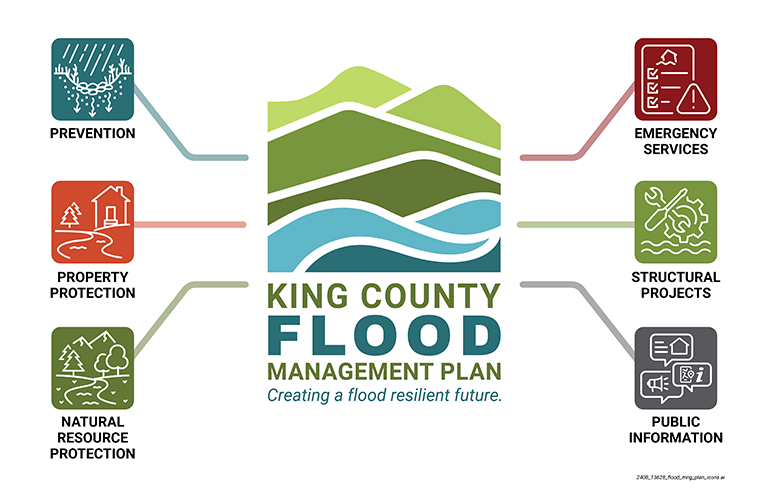King County’s comprehensive new flood plan capitalizes on the latest climate science, adapts to increased flood risks in urban and coastal communities
Summary
Oct. 16, 2024: King County’s new flood plan – shaped by frontline communities during an extensive public engagement – capitalizes on the latest climate science to better prepare communities for changing flood risks.
News
King County’s first complete update of its Flood Management Plan since 2006 capitalizes on the latest climate science to describe how flood risks in urban and coastal communities and along tributary streams are expected to change in the future. It also identifies actions that will reduce flood risk, improve habitat, and enhance the resilience of communities.
Severe flooding – already the most common natural disaster in King County – is expected to occur more frequently due to climate change. The comprehensive plan will guide investments, strategies, and actions to mitigate increasing flood risk.
The King County Council in September unanimously approved the plan proposed by Executive Dow Constantine.
“Our comprehensive new flood plan – shaped by frontline communities and guided by the latest climate science – outlines strategic actions that will better protect people, homes, and infrastructure,” said Executive Constantine. “Floodwaters don’t recognize borders, so we are expanding our approach to adapt to increasing flood risks in urban and coastal communities, promoting a more equitable, resilient future for our region.”


Residents are encouraged to sign up for flood alerts, download the flood warning app, learn how to prepare for flooding, and find out about resources and services at kingcounty.gov/FloodServices.
In addition to proposing ways to mitigate flood risks along the county’s major river corridors, the updated flood plan marks the first time King County’s flood planning explores flood risks along smaller creeks and streams as well as urban and coastal communities. Recognizing that floodwaters cross jurisdictional boundaries, the flood plan identifies partnerships as an important way to build flood resilience countywide.
The Department of Natural Resources and Parks conducted extensive public engagement during the planning effort to ensure the plan reflects community needs and priorities. To obtain community and partner input, they established an online Engagement Hub, participated in community-led events, workshops, and online public meetings, conducted surveys, and distributed frequent email newsletter updates that highlighted comment opportunities. Engagement emphasized frontline communities disproportionately affected by flooding and the impacts of climate change.
"Our most successful strategies are ones based on community expertise and the latest science, and that’s what our staff achieved with the new flood plan,” said John Taylor, Director of the King County Department of Natural Resources and Parks. “They produced the clear roadmap we need to help both rural and urban communities better prepare for increasing flood risks.”

The updated flood plan builds stronger alignment with King County’s Strategic Climate Action Plan, which includes a focus on reducing risks from sea level rise and increased river flooding.
"Climate change is a force multiplier, causing severe floods to occur more frequently in more communities,” said Marissa Aho, Director of the King County Executive Climate Office. “We are applying the same community-led approach to better prepare our region for flooding that we are using to increase resilience to other increasing risks, including wildfire and extreme heat.”
The plan identifies opportunities to achieve multiple benefits with floodplain restoration projects, modeling successes along the Snoqualmie River, the Green River, and the Cedar River that simultaneously improved habitat and reduced flood risks. Producing multiple benefits for people, fish, and wildlife is a fundamental principle of Clean Water Healthy Habitat.
"As elected leaders and policymakers, our primary responsibility is to the safety and wellbeing of our residents and infrastructure. The increase in flood and flood-related hazards along our rivers and streams across the County requires that we adapt our practices to better meet these growing risks to our communities," said King County Councilmember Sarah Perry. "The passage of the Flood Management Plan, which was last updated in 2006, brings forward the results of impactful community engagement and best available science to guide our efficient and effective response to flooding for decades to come, and I am very excited about our ability to better respond from the passage of this update."
The update was developed by King County’s Water and Land Resources Division, one of four divisions at the Department of Natural Resources and Parks.
Multimedia
- VIDEO: Updating King County's Flood Management Plan
- VIDEO: B-roll package available to download
- PHOTO GALLERY: Flooding in King County
- TRACKS: An interactive map of environmental stewardship
Resources
- Sign up for alerts and learn how to prepare for flooding
- King County Flood Management Plan
- Clean Water Healthy Habitat
Quotes
Our comprehensive new flood plan – shaped by frontline communities and guided by the latest climate science – outlines strategic actions that will better protect people, homes, and infrastructure. Floodwaters don’t recognize borders, so we are expanding our approach to adapt to increasing flood risks in urban and coastal communities, promoting a more equitable, resilient future for our region.
As elected leaders and policymakers, our primary responsibility is to the safety and wellbeing of our residents and infrastructure. The increase in flood and flood-related hazards along our rivers and streams across the County requires that we adapt our practices to better meet these growing risks to our communities. The passage of the Flood Management Plan, which was last updated in 2006, brings forward the results of impactful community engagement and best available science to guide our efficient and effective response to flooding for decades to come, and I am very excited about our ability to better respond from the passage of this update.
Our most successful strategies are ones based on community expertise and the latest science, and that’s what our staff achieved with the new flood plan. They produced the clear roadmap we need to help both rural and urban communities better prepare for increasing flood risks.
Flooding occurs most frequently out of the hazards that affect King County. The King County Office of Emergency Management coordinates with the other King County departments, cities within the County, and community organizations, to develop high level plans to prepare for, mitigate, respond to, and recover from these hazards. The new flood plan outlines details and strategies that are based on science and input from those most affected, and will guide King County on how to prioritize and to best use funding opportunities from state and federal resources to reduce flood risk and increase community resilience.
Climate change is a force multiplier, causing severe floods to occur more frequently in more communities. We are applying the same community-led approach to better prepare our region for flooding that we are using to increase resilience to other increasing risks, including wildfire and extreme heat.
Contact
Doug Williams, Department of Natural Resources and Parks, 206-477-4543
 Translate
Translate